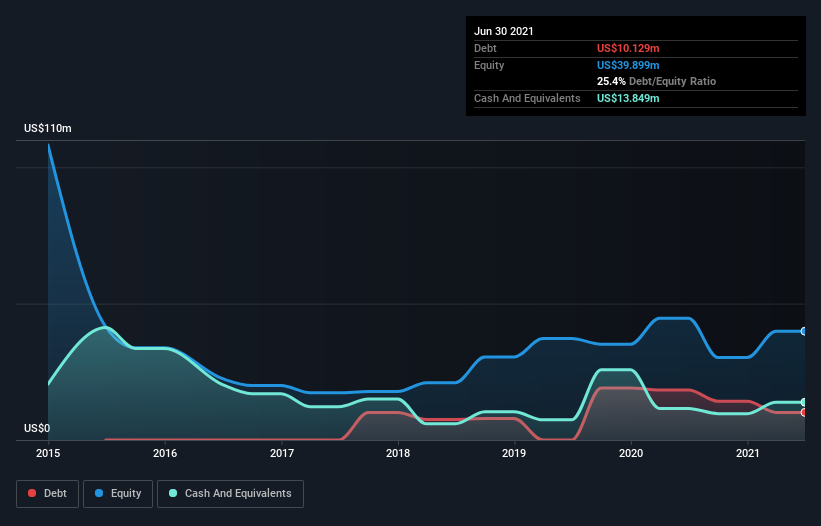Does Otto Energy (ASX:OEL) Have A Healthy Balance Sheet?
The external fund manager backed by Berkshire Hathaway's Charlie Munger, Li Lu, makes no bones about it when he says 'The biggest investment risk is not the volatility of prices, but whether you will suffer a permanent loss of capital.' So it seems the smart money knows that debt - which is usually involved in bankruptcies - is a very important factor, when you assess how risky a company is. Importantly, Otto Energy Limited (ASX:OEL) does carry debt. But the more important question is: how much risk is that debt creating?
What Risk Does Debt Bring?
Generally speaking, debt only becomes a real problem when a company can't easily pay it off, either by raising capital or with its own cash flow. If things get really bad, the lenders can take control of the business. However, a more frequent (but still costly) occurrence is where a company must issue shares at bargain-basement prices, permanently diluting shareholders, just to shore up its balance sheet. Of course, plenty of companies use debt to fund growth, without any negative consequences. The first step when considering a company's debt levels is to consider its cash and debt together.
Check out our latest analysis for Otto Energy
How Much Debt Does Otto Energy Carry?
The image below, which you can click on for greater detail, shows that Otto Energy had debt of US$10.1m at the end of June 2021, a reduction from US$18.3m over a year. But it also has US$13.8m in cash to offset that, meaning it has US$3.72m net cash.
How Healthy Is Otto Energy's Balance Sheet?
We can see from the most recent balance sheet that Otto Energy had liabilities of US$14.7m falling due within a year, and liabilities of US$6.70m due beyond that. Offsetting these obligations, it had cash of US$13.8m as well as receivables valued at US$3.88m due within 12 months. So its liabilities total US$3.70m more than the combination of its cash and short-term receivables.
Since publicly traded Otto Energy shares are worth a total of US$39.1m, it seems unlikely that this level of liabilities would be a major threat. However, we do think it is worth keeping an eye on its balance sheet strength, as it may change over time. Despite its noteworthy liabilities, Otto Energy boasts net cash, so it's fair to say it does not have a heavy debt load!
We also note that Otto Energy improved its EBIT from a last year's loss to a positive US$203k. When analysing debt levels, the balance sheet is the obvious place to start. But it is Otto Energy's earnings that will influence how the balance sheet holds up in the future. So when considering debt, it's definitely worth looking at the earnings trend. Click here for an interactive snapshot.
Finally, while the tax-man may adore accounting profits, lenders only accept cold hard cash. While Otto Energy has net cash on its balance sheet, it's still worth taking a look at its ability to convert earnings before interest and tax (EBIT) to free cash flow, to help us understand how quickly it is building (or eroding) that cash balance. Over the last year, Otto Energy actually produced more free cash flow than EBIT. That sort of strong cash generation warms our hearts like a puppy in a bumblebee suit.
Summing up
We could understand if investors are concerned about Otto Energy's liabilities, but we can be reassured by the fact it has has net cash of US$3.72m. The cherry on top was that in converted 1,874% of that EBIT to free cash flow, bringing in US$3.8m. So we are not troubled with Otto Energy's debt use. There's no doubt that we learn most about debt from the balance sheet. However, not all investment risk resides within the balance sheet - far from it. For example, we've discovered 2 warning signs for Otto Energy that you should be aware of before investing here.
When all is said and done, sometimes its easier to focus on companies that don't even need debt. Readers can access a list of growth stocks with zero net debt 100% free, right now.
This article by Simply Wall St is general in nature. We provide commentary based on historical data and analyst forecasts only using an unbiased methodology and our articles are not intended to be financial advice. It does not constitute a recommendation to buy or sell any stock, and does not take account of your objectives, or your financial situation. We aim to bring you long-term focused analysis driven by fundamental data. Note that our analysis may not factor in the latest price-sensitive company announcements or qualitative material. Simply Wall St has no position in any stocks mentioned.
Have feedback on this article? Concerned about the content? Get in touch with us directly. Alternatively, email editorial-team (at) simplywallst.com.

 Yahoo Finance
Yahoo Finance 
